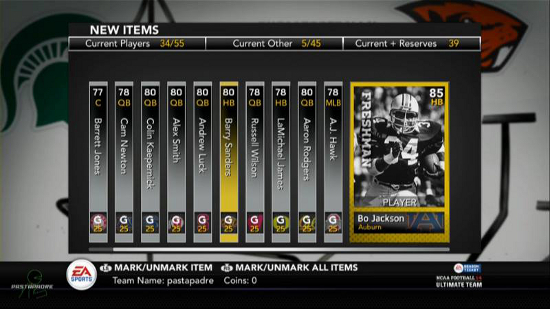Early Impressions of Ultimate Team Mode in NCAA Football 14

Upon the first announcement of NCAA Football 14 receiving an Ultimate Team mode the initial reaction of many including myself was to express how it really didn’t seem to be a good fit and its appeal would be limited. An agreement with the NFLPA allowed for access to active professional players that would be recreated as their collegiate selves.
Would there really be excitement about having NFL players in the NCAA game? Would putting teams together with them be all that compelling? Rivalries are such an important part of college football that die hard fans may not have found much interest in compiling a team full of players that they had never rooted for or actively rooted against. More casual fans though appeared to have the potential of being compelled by the concept.
Despite the skepticism, over time I became more intrigued by what Ultimate Team in NCAA would be offering. An opportunity to go back and re-visit players as they stood in their collegiate days. The ability to craft a team and go head-to-head against those utilizing players that may now be household names, those that were big names at the time but faded away, as well as ones that would be unfamiliar and learned about through the process.
The first day with Ultimate Team showed some of its potential but also a few of the drawbacks.
The mode starts out by presenting the choice of the “starter team” which provides the first uniforms and playbook. This allows for fans to at least have some connection to their team which was a smart move on EA’s part. Even a couple former players seem to be tossed in to the first card pack based on the chosen school.
Next is to open up the starter pack. This is a mix of decent (mid-upper 70s) and backup caliber players along with the “freshman” version of Bo Jackson (85 overall) and Barry Sanders (80 overall). Other redemption opportunities from the demo, pre-order incentives (which turned out to be very weak), and Nike Skills Trainer can also be redeemed at that time. That will be the foundation of the team for the time being unless money is spent on buying packs of cards.
At that point it’s time to set the roster and move others into reserves so as to preserve their contracts. The team can be named from the “Settings” area. Then on to playing some online head-to-head games or take on the CPU in challenges to earn coins or card packs. The online games seem to be locked at three minute quarters likely with the intention of promoting more games being played rather than each one being a satisfying strategic experience. That might be why no one seems to want to ever punt. The 10 game “seasons” and playoff provides the main motivation to keep playing and it works in that sense giving each game added purpose. There doesn’t seem to be a way to challenge anyone directly to games.

The coolest experience so far has been the CPU challenge taking on a legendary Miami Hurricanes team which is comprised of some of the greatest to play for the program like Ray Lewis, Ed Reed, Antrel Rolle, Andre Johnson, Michael Irvin, Santana Moss, Devin Hester, Kellen Winslow Jr., Edgerrin James, Willis McGahee, Doug Flutie, and Larry Fitzgerald.
Wait…Flutie and Fitzgerald? Unfortunately it seems roster spots that lack an eligible player from the program’s past will suffer with replacements coming from others teams in their respective conferences. Still it was neat to have all those players on the field and even on Varsity difficulty good luck shutting down that offense with your crappy defensive players. Coincidentally I lost my first attempt on a Doug Flutie hail mary as time expired – the play that his Boston College team beat the Hurricanes with in 1984.
One of the biggest weaknesses with this Ultimate Team so far are the likenesses – or lack thereof. Some players are represented well (see Brandon Marshall) while others are basically generic created players (see Russell Wilson) and others have graphical errors (see Cam Newton). The focus of the mode may not necessarily be on identifying players on the field but rather having them at your disposal with the ratings they provide and creating collections. Understandably it would be a ton of work to get them all in and how they looked at that age. Still it’s immediately distracting that so many players look nothing like they should.
Presentation is pretty much stripped out from the head-to-head online games while the CPU challenges have elements like the intro video packages which are even more awkward than usual featuring players you’re not accustomed to in the uniform.
That leads to another problem in that the presentation doesn’t display what players are being faced. There is no easy or immediately evident way to get a clear picture of the opposition’s roster. With so many players involved in the mode (a good many of which won’t be immediately identified) and there being different variations of each one possible there is no way to properly assess who to be aware of and their skill sets to create an offensive or defensive gameplan. You’re basically flying blind and that isn’t a great feeling.
After one day with Ultimate Team the mode is about where I anticipated it would be. There are a lot of interesting ideas that have been implemented but it falls short with some of them either due to limitations or aspects that went overlooked. More about Ultimate Team will be discussed during the week and summarized in the full Hits and Misses review. Check out the set of screenshots that were taken from a handful of games and during the setup process for the mode.
